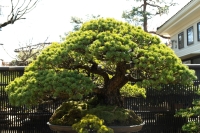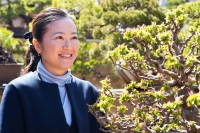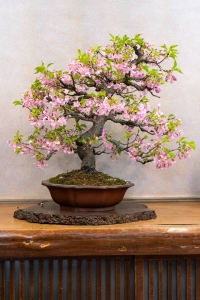As living things, bonsai require care, dedication and commitment. With that in mind, Kaori Yamada says she feels the same way toward her bonsai as pet owners may feel toward their furry friends.
“There is a feeling we can gain simply because we are taking care of this tree,” Yamada says. “When a flowering bonsai blooms, even if it's one flower, we thank it. We watered it (and) showed it love, and it rewards us with flowers.”
Yamada, 46, is one of Japan’s few women bonsai masters, living and working in Seikouen Bonsai in Omiya, Saitama Prefecture. Yamada grew up surrounded by bonsai her whole life and was expected to carry on her family's 170-year-old legacy or otherwise end it. She is now a fifth-generation bonsai master whose mission is to share her family’s accumulated knowledge with the world and make the practice more accessible.
As tourism to Japan and the global exportation of Japanese crafts has risen, so has an interest in the artform, which dates back to around the seventh and eighth centuries. But what makes bonsai different from any other potted plant?
“The difference is that a bonsai depicts a great natural landscape, such as Japan’s mountainous scenery,” Yamada explains. “By using this tiny tree and tiny pots, we can enjoy the beauty of nature on a small scale.”
Another distinction, she adds, is “whether there is expression or not.”
“Bonsai contains the intention of the grower, so we distinguish it as having been shaped by someone. This is the great difference.”
An additional factor is longevity — while it’s hard to imagine most house plants living for very long (many of us struggle to keep an orchid alive over a single winter) bonsai can live hundreds of years. At an estimated 1,000 years old, the oldest recorded bonsai is said to be a Ficus retusa linn shrub currently located in northern Italy’s Crespi Bonsai Museum. Yamada herself cares for a 350-year-old goyōmatsu (five-needle pine) bonsai that has been handed down through generations of her family.
Yamada sees the bonsai in her care as “long-living family members,” referring to the older ones as “senpai” (a term used to address someone of seniority). She even owes her name to one of her family's bonsai.
“Before my birth, there was an ume (plum) bonsai that hadn’t flowered in many years,” Yamada says “In the February I was born, it put forth two blossoms — it was like a sign. I was named Kaori, meaning ‘fragrance’ referring to the ume.”
Putting down roots
Signs or no, being a part of a family legacy as an only child came with a certain amount of pressure — “Big pressure,” Yamada says with a laugh.
As a teenager, Yamada struggled with the knowledge that if she chose not to follow in her father’s footsteps, her family's legacy and the bonsai garden would be finished. This has unfortunately been the reality for many traditional Japanese crafts, as younger generations are opting out of their family businesses, leaving many techniques to die out.
For Yamada, there was extra pressure in taking up the vocation of her father, the revered bonsai master Tomio Yamada, which meant working in a traditionally male-dominated landscape.
“I love bonsai, but considering going into it as a career when I was a young woman was tough,” she says, adding that while few women make a living out of bonsai, even fewer attain the rank of master. “Historically, bonsai culture was considered to be the hobby of the elderly, especially older men.”
While historically male-dominated in the past, the pursuit of ikebana flower arrangement has seen a relative proliferation of women masters in the modern era. The field of bonsai, however, has yet to see this kind of growth — something Yamada wants to change.
“I strongly feel that, over generations, (bonsai) will spread to include younger people and women,” she says. “Bonsai culture is not only for men.”
In 1999, to encourage more women to get involved, Yamada started teaching the art of cultivating saika bonsai ー a much smaller version of the tree that features colorful flowers and grasses. Plants in this style are easier to create and maintain, making saika bonsai a much more realistic challenge for newcomers. Many older masters do not consider this to be true bonsai, with traditional bonsai featuring just one tree or a grouping of the same species of tree in a single, shallow pot. Adding grasses and flowers is not part of traditional bonsai as some say it softens the look of the restrained and sculpted miniature trees, but Yamada sees saika as maintaining realistic depictions of the Japanese landscape.
Regardless of what others may say, Yamada has had success with her saika bonsai class — it currently has 2,300 students across both in-person and online lessons.
Flowering pursuits
Yamada believes that learning the art of bonsai is the perfect antidote to today's fast-paced world.
When bonsai was first introduced to Japan (estimated to be during the Heian Period [794-1185]), the craft spread through Chinese Zen Buddhist monks who taught in monasteries. Since then, the practice has long been associated with Zen principles.
“Bonsai can teach us about the flow of time,” Yamada says. “They allow us to be mindful and meditative, which is very beneficial for those living in a stressful, digital world.”
Learning bonsai can also allow us to become more deeply attuned to our natural surroundings.
“It doesn’t have to be Japan,” Yamada says. “It can be (anywhere) you connect with. When we grow bonsai, we are inspired by all aspects of the landscape, even rivers or mountains.”
Bonsai then can serve as a miniature window into a natural world filled with beauty.
“This is perhaps the most rewarding part of taking care of bonsai — an escape from the realities of daily life.”
For beginners, Yamada knows that bonsai can be daunting. Nobody wants to be responsible for the death of a 100-year-old tree.
“If you think too stressfully about it, you won’t start at all,” Yamada says. “It’s better to start thinking just three months ahead — after that, six months, then a year. Take it one step at a time.”
Before owning your own bonsai, Yamada recommends finding a community or classes to become more familiar with the variety of plants you can work with. Once you’re ready to cultivate your own bonsai, there’s a bit of specialized preparation required. Much as a pet owner would buy supplies and equipment tailored to their animal of choice, bonsai as well requires its own unique pruning shears, fertilizer and the right location in your home for light, temperature and more.
For Yamada, her work moving bonsai forward continues — a passion project where not even the sky’s the limit.
“When we travel to space,” she says, “I think that bonsai should accompany us, bringing a natural and spiritual thing to a place that is considered inhospitable.”


























With your current subscription plan you can comment on stories. However, before writing your first comment, please create a display name in the Profile section of your subscriber account page.